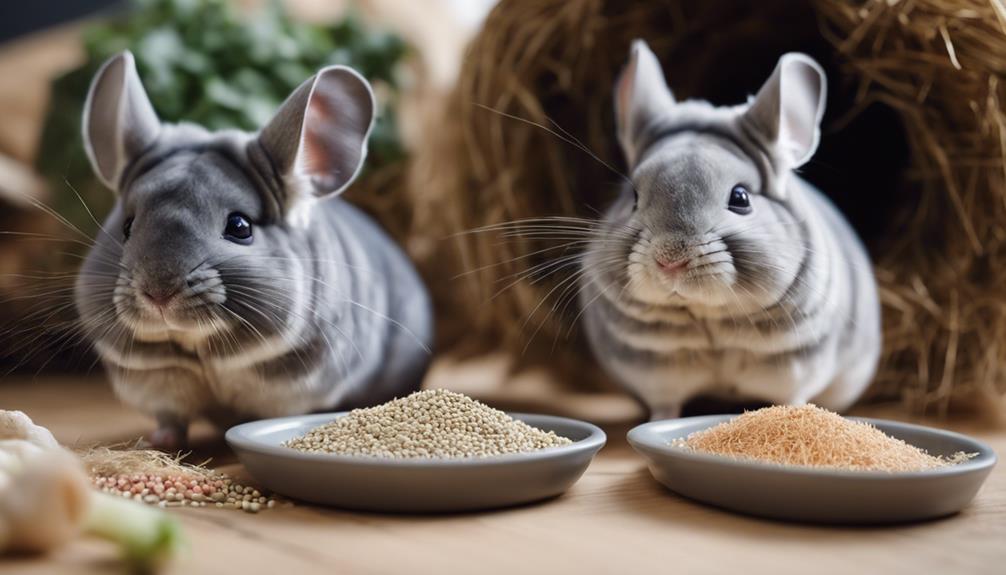Do Different Chinchilla Species Have Different Care Requirements?

Chinchillas are adorable and low-maintenance pets. There are two common species of chinchillas kept as pets: the Chinchilla lanigera and the Chinchilla brevicaudata. It is important to understand the differences between these species to provide the best care possible.
Chinchilla lanigera, also known as the long-tailed chinchilla, is the more common species kept as pets. They are larger in size and have longer tails compared to Chinchilla brevicaudata. Chinchilla brevicaudata, or the short-tailed chinchilla, is smaller in size with a shorter tail.
Each species has its own specific care requirements. It is essential to tailor your chinchilla's care based on its species to ensure optimal health and happiness. Proper diet, housing, and handling techniques may vary between the two species, so it's important to do your research and consult with a veterinarian experienced in chinchilla care if needed.
Short-Tailed Vs. Long-Tailed Chinchillas
Short-tailed and long-tailed chinchillas exhibit distinct physical characteristics that can impact their care requirements. Tail length impacts both species in various ways, influencing their behavior and interactions with their environment. Long-tailed chinchillas, as the name suggests, possess longer tails compared to their short-tailed counterparts. This difference affects their balance and agility, allowing long-tailed chinchillas to navigate their surroundings more adeptly. On the other hand, short-tailed chinchillas may struggle with certain activities that require precise movements due to their shorter tails.
Behavioral differences also play a significant role in the care of these chinchilla species. Long-tailed chinchillas tend to be more active and curious, often exploring their surroundings with enthusiasm. Short-tailed chinchillas, while still curious, may exhibit a slightly calmer demeanor. Understanding these behavioral nuances is crucial for providing appropriate mental stimulation and enrichment for both species. By tailoring their care to accommodate these differences, caregivers can ensure the health and well-being of their chinchillas.
Dietary Variances Among Chinchilla Species

Chinchilla species exhibit distinct feeding behaviors, with some showing preferences for specific food types. These differences in feeding behavior often reflect variations in their nutritional needs.
Understanding these dietary variances is crucial for providing optimal care tailored to the specific species' requirements.
Feeding Behavior Differences
Among the various species of chinchillas, differences in feeding behavior and dietary preferences are notable, reflecting their distinct ecological adaptations. Chinchillas exhibit varied feeding preferences and digestive differences based on their species. Some may have a higher tolerance for certain foods, while others may need a more specific diet due to their unique nutritional requirements. Understanding these dietary habits is essential for providing optimal care to different chinchilla species.
- Chinchilla species may have specific feeding preferences based on their natural habitat.
- Digestive differences among chinchilla species can impact their ability to digest certain foods effectively.
- Nutritional requirements vary between chinchilla species, influencing their dietary habits and preferences.
Nutritional Needs Variations
How do the dietary preferences of different chinchilla species reflect their ecological adaptations and nutritional needs?
Chinchilla species such as the short-tailed chinchilla (Chinchilla chinchilla) and the long-tailed chinchilla (Chinchilla lanigera) have varying protein requirements and digestive differences due to their distinct habitats and evolutionary history.
Short-tailed chinchillas, native to the Andes Mountains, have adapted to a diet rich in fibrous vegetation, requiring higher protein levels to support their energy needs in the harsh mountain environment.
In contrast, long-tailed chinchillas, found in more arid regions, have evolved to efficiently digest lower-protein diets with a greater emphasis on water conservation.
Understanding these species-specific nutritional needs is crucial for providing optimal care and promoting the health and well-being of chinchillas in captivity.
Tailoring Habitat Needs for Different Chinchillas

When considering the unique habitat needs of various chinchilla species, it's crucial to acknowledge their specific environmental requirements for optimal health and well-being. Different chinchilla species may have varying preferences and necessities when it comes to their habitat.
- Housing preferences: Some chinchilla species may prefer multi-level cages with platforms and ramps, while others might thrive in more straightforward setups. Understanding the specific housing needs of each species is essential for their well-being.
- Temperature requirements: Certain chinchilla species are more tolerant of colder temperatures, while others may require a more stable and warmer environment. Providing the appropriate temperature conditions is vital for their comfort and health.
- Exercise needs: Chinchillas, regardless of species, require ample space and opportunities for exercise to maintain their physical health. Tailoring the habitat to encourage movement and play is crucial for their overall well-being.
Considering these factors, along with the social interactions each species may require, is key to providing a habitat that meets the specific needs of different chinchilla varieties.
Grooming Distinctions Across Chinchilla Varieties

Chinchilla species exhibit distinct differences in fur texture and tail length, which directly impact their grooming needs. Understanding these variations is crucial for providing tailored care to each chinchilla variety.
Fur Texture Differences
Among the various chinchilla species, differences in fur texture play a significant role in determining grooming needs and distinctions across the different varieties. Chinchillas exhibit various fur textures, impacting their care requirements. Here are some essential points to consider:
- Coat coloration distinctions affect the fur texture, with some species having softer or denser fur.
- Housing requirements adaptations are necessary based on fur texture variations to maintain optimal health and comfort.
- Regular grooming routines are crucial to address specific needs related to fur texture differences among chinchilla varieties.
Understanding these fur texture disparities is key to providing tailored care for different chinchilla species.
Tail Length Variances
In observing chinchilla species, notable variations in tail length can be identified, impacting grooming practices tailored to each variety. Chinchillas exhibit diverse tail anatomy, ranging from short to long tails, influencing their grooming techniques and habitat preferences. Understanding these differences is crucial for providing optimal care. Short-tailed chinchillas, such as the Short-tailed Chinchilla (Chinchilla chinchilla), require less maintenance in terms of grooming due to their shorter tails, which are less prone to tangling. On the other hand, long-tailed species like the Long-tailed Chinchilla (Chinchilla lanigera) demand more attention to prevent matting and tangling. Tail length also correlates with habitat preferences, with short-tailed chinchillas often found in rocky terrains where shorter tails are advantageous for maneuverability.
| Tail Length | Species | Grooming Needs |
|---|---|---|
| Short | Short-tailed Chinchilla | Less maintenance |
| Long | Long-tailed Chinchilla | More attention |
Health Considerations Based on Chinchilla Species

When considering the health of different chinchilla species, it's crucial to understand their specific dietary and environmental needs to ensure their well-being and prevent potential health issues. Each chinchilla species has unique characteristics that can impact their health, requiring tailored care strategies.
- Species Specific Health Considerations: Different chinchilla species may have varying susceptibilities to certain health conditions, necessitating specific monitoring and preventive measures.
- Genetic Predispositions in Chinchillas: Understanding the genetic predispositions of each chinchilla species can help anticipate potential health issues and take proactive steps to mitigate risks.
- Environmental Adaptations: Consider the natural habitats of different chinchilla species when setting up their living environment to promote their health and well-being effectively.
Behavioral Differences in Chinchilla Care

Considering the unique behavioral characteristics exhibited by different chinchilla species is essential for tailoring their care effectively. Chinchillas are social creatures that thrive on interaction and mental stimulation. Providing enrichment activities is crucial to ensure their well-being. Different species may have varying preferences when it comes to social interactions and enrichment, highlighting the importance of understanding these differences for proper care.
| Enrichment Activities | Social Interactions | Behavioral Traits |
|---|---|---|
| Chewing toys and sticks | Group playtime | Active and curious nature |
| Exercise wheels | Pair-bonding activities | Nocturnal habits |
| Hideouts and tunnels | Vocalizations | Territorial tendencies |
| Climbing structures | Grooming rituals | Agile and nimble movements |
| Foraging toys | Scent-marking behavior | Preference for routine |
Conclusion: Tail-Length Impact on Chinchilla Care

Taking into account the various chinchilla species' tail lengths is crucial for tailoring their care effectively. Chinchillas with longer tails, such as the Long-Tailed Chinchilla, may have specific needs compared to those with shorter tails, like the Short-Tailed Chinchilla. Understanding the impact of tail length on chinchilla care can lead to better overall welfare and health for these adorable creatures.
Key Points:
- Tail care: Longer-tailed chinchillas may require extra attention to prevent tail injuries or tangling.
- Housing preferences: Chinchillas with different tail lengths might prefer distinct types of enclosures to accommodate their tail lengths comfortably.
- Behavioral considerations: Tail length could influence a chinchilla's behavior, affecting their interaction with toys and accessories in their environment.
Frequently Asked Questions
Can Different Chinchilla Species Be Housed Together?
Chinchilla species should not be housed together due to social dynamics and behavioral differences. Mixing them can lead to stress, aggression, and potential harm. It's crucial to provide suitable companionship within the same species.
Are There Specific Exercise Requirements for Different Chinchilla Species?
In tail-wagging symphonies of joy, chinchillas revel in their exercise routines, showcasing their unique socialization needs. Diverse species may exhibit nuanced nutritional requirements and grooming practices, demanding attentive care from their keepers.
Do Different Chinchilla Species Have Varying Lifespans?
Different chinchilla species exhibit varied lifespans due to genetic factors and environmental influences. These differences may necessitate tailored care routines, including specific diet adjustments, grooming needs, habitat preferences, and environmental enrichment strategies.
Are Certain Chinchilla Species More Prone to Specific Health Issues?
Certain chinchilla species may exhibit genetic predispositions to specific health issues. Environmental factors can also play a role. Providing tailored preventative care, understanding unique dietary needs, and monitoring closely are essential for maintaining the well-being of different chinchilla species.
How Do Different Chinchilla Species Interact With Each Other in a Multi-Chinchilla Household?
Chinchilla species exhibit unique social dynamics and behaviors when introduced in a multi-chinchilla household. Understanding their interactions is crucial for a harmonious cohabitation. Observing their behavior can help in managing potential conflicts and ensuring a peaceful environment.










